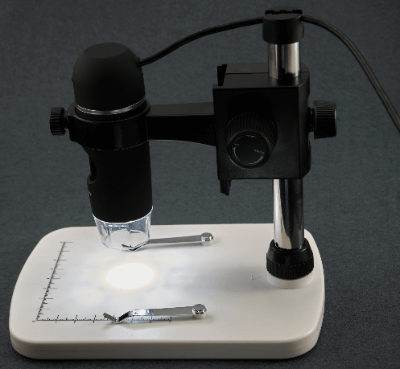What Is a USB Microscope?
 A USB Microscope is an innovative digital device that sets itself apart from traditional optical microscopes.
A USB Microscope is an innovative digital device that sets itself apart from traditional optical microscopes.
As the name implies, this microscope can be connected directly to a computer or mobile device via a USB interface, and combines high-resolution digital imaging with comfortable operation. The USB Microscope transforms observation, which in conventional microscopes requires physical visual inspection or the attachment of an external camera. It is now possible to instantly acquire images as digital image data.
For technicians and researchers in particular, the ability to easily share and store high-resolution images of samples in real time is an extremely significant advantage. This compact yet high-performance device is expected to be used in a wide range of settings, including research facilities, educational institutions, and industry.
Uses of the USB Microscope
1. Quality Control and Inspection in Industry
USB Microscope is relied upon to detect minute defects in precision components and circuit boards. High-resolution digital imaging can be utilized to quickly identify flaws and defects on the production line.
2. Biological and Medical Research
USB Microscope is very useful in situations where real-time, high-resolution image acquisition of cells and microorganisms is required. Detailed analysis and comparative studies can be easily performed based on the stored data.
3. Tool for Education and Training
In educational institutions and training centers, the USB microscope can be used to capture digital images of objects that learners wish to observe and share them on a large screen or as discussion materials.
4. Detailed Analysis of Art and Archaeology
USB Microscope can be useful in investigating the detailed structure and techniques of ancient artifacts and works of art. Since the microscopes allow nondestructive and non-contact examination of minute details, detailed analysis can be performed while preserving the condition of the object.
5. Gemstone and Ore Appraisal
The USB Microscope is the appraiser’s trusted tool when observing features and defects in gemstone and ore details. The highly accurate images are also useful for identifying genuine and fake items.
Principle of USB Microscope
The USB Microscope emerged as a device that combines traditional optical microscopy with digital technology. The main mechanisms and principles of this microscope are as follows:
1. Optical System
The first basic component is the optical system. Like an optical microscope, it contains a built-in lens for magnifying and observing an object. Most USB Microscopes can combine multiple lenses to provide precise observation according to the required magnification.
2. Digital Image Sensor
This is the most distinctive feature of this microscope. In contrast to traditional microscopes, which observe directly with the eye, USB Microscopes utilize a digital sensor to capture the magnified object as a digital image. This sensor is commonly referred to as a CMOS or CCD sensor.
3. Digital Signal Processing
The data captured by the image sensor is converted to digital signals through a built-in processor. At this stage, various image quality optimizations may be performed, such as color correction and sharpness adjustment of the image.
4. USB Interface
The converted digital signal is sent to a computer or mobile device via a USB interface. This USB connection enables high-speed data transfer and real-time high-resolution image observation.
5. Software Integration
Many products are bundled with dedicated software that works with the USB Microscope. This allows easy access to functions such as image capture, analysis, storage, and sharing.
Types of USB Microscopes
As USB Microscope technology has evolved, products with a wide variety of shapes and functions have appeared on the market. Here, we will explain the main types: “desk type” and “handheld type,” in detail.
1. Desk Type
| Overview | The desk-type USB microscope is designed for use on a desk in a laboratory or office. It features a microscope body fixed to a stable pedestal or stand. |
| Stability | The fixed pedestal makes the microscope less susceptible to vibration and camera shake. |
| High Precision | Precise focus adjustment and observation at high magnification are easy. |
| Expandability | Various options can be attached, such as additional lighting, filters, and special lenses. |
| Main Applications | Research requiring precise observation and analysis, industrial quality inspection, use of educational materials at educational institutions, etc. |
2. Handheld Type
| Overview | The handheld USB microscope is designed for portability and immediate convenience. It can be held in the hand and brought directly up close to the object being observed, making it extremely flexible for use. |
| Mobility | Compact and lightweight, it can be used anywhere. |
| Intuitive operation | Observation can be easily performed without complicated settings or adjustments. |
| Main Applications | Outdoor fieldwork, field surveys, experiments and observations in educational settings, hobby and educational use for general consumers. |
In selecting these types, it is important to choose the appropriate type according to the scene of use and your needs. Both types have the basic functions of a USB Microscope, and both types will provide the maximum effect depending on how they are used and for what purpose they are used.